Mapping China’s Changing Gross Domestic Product Distribution Using Remotely Sensed and Point-of-Interest Data with Geographical Random Forest Model
Abstract
1. Introduction
2. Data and Methods
2.1. Data Source and Preprogressing
2.1.1. GDP Statistical Data and Boundary of Administrative Units
2.1.2. Grid Data
2.1.3. POI Data
2.2. Methods
2.2.1. Geographical Random Forest
2.2.2. GDP Density Mapping
2.2.3. Accuracy Assessment
2.2.4. Spatial Barycenter Model
3. Results
3.1. Multitemporal GDP Density Maps
3.2. Spatiotemporal Changes in GDP Density
3.3. Regional Difference of Random Forest Variable Importance
4. Discussion
4.1. Comparison with the Open Access Gridded GDP Datasets
4.2. Change in GDP Density over the Past Decades
4.3. Regional Differences in Random Forest Variable Importance
4.4. Limitation and Future Work
5. Conclusions
Author Contributions
Funding
Institutional Review Board Statement
Informed Consent Statement
Data Availability Statement
Acknowledgments
Conflicts of Interest
Appendix A
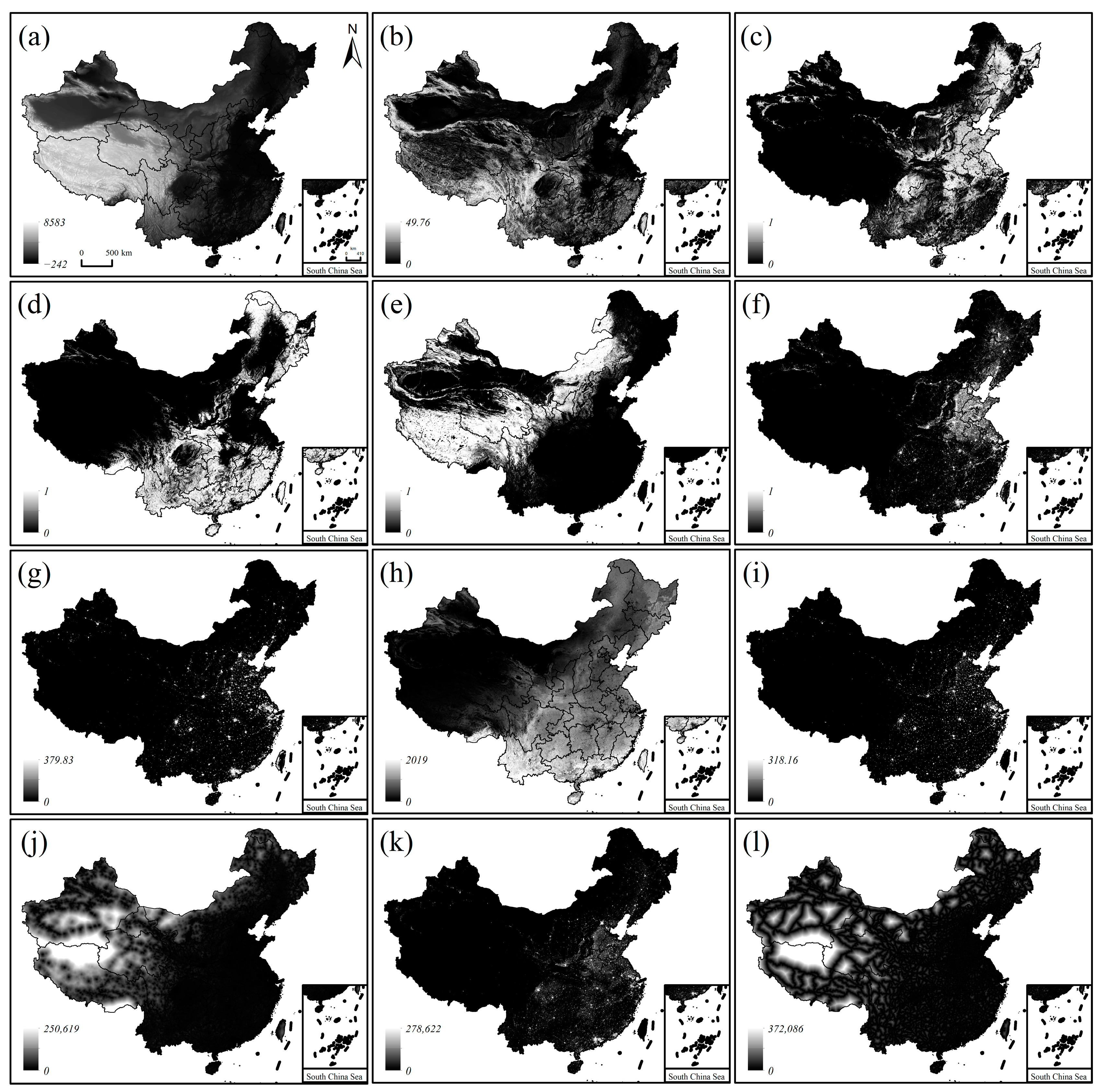
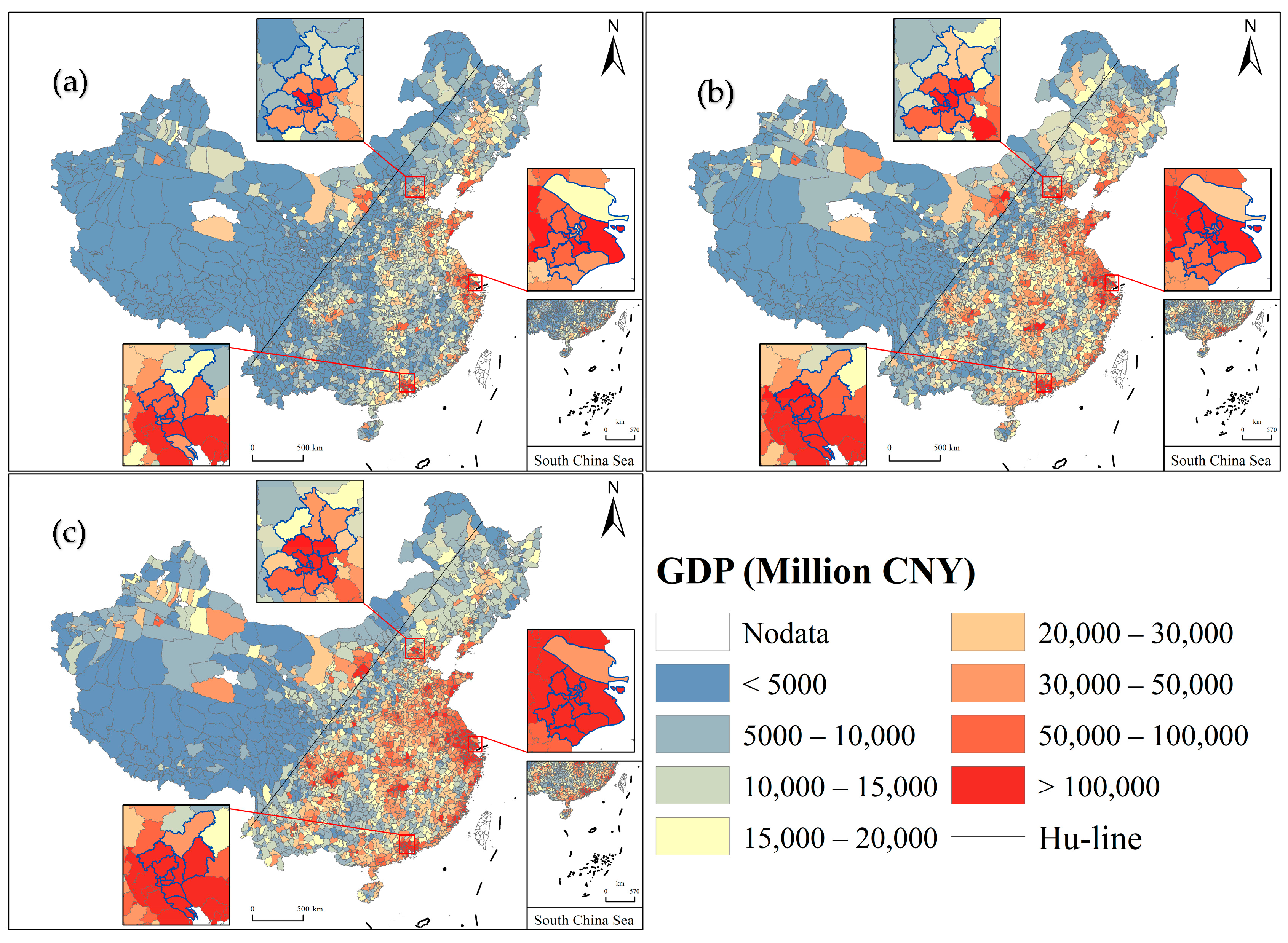
References
- Geiger, T. Continuous national gross domestic product (GDP) time series for 195 countries: Past observations (1850–2005) harmonized with future projections according to the shared socio-economic pathways. Earth Syst. Sci. Data 2018, 10, 847–856. [Google Scholar] [CrossRef]
- Henderson, J.V.; Storeygard, A.; Weil, D.N. Measuring Economic Growth from Outer Space. Am. Econ. Rev. 2012, 102, 994–1028. [Google Scholar] [CrossRef] [PubMed]
- Sun, J.; Di, L.; Sun, Z.; Wang, J.; Wu, Y. Estimation of GDP Using Deep Learning With NPP-VIIRS Imagery and Land Cover Data at the County Level in CONUS. IEEE J. Sel. Top. Appl. Earth Obs. Remote Sens. 2020, 13, 1400–1415. [Google Scholar] [CrossRef]
- Wang, X.; Sutton, P.C.; Qi, B. Global Mapping of GDP at 1 km2 Using VIIRS Nighttime Satellite Imagery. Isprs Int. J. Geo-Inf. 2019, 8, 580. [Google Scholar] [CrossRef]
- Chen, X.; Nordhaus, W.D. Using luminosity data as a proxy for economic statistics. Proc. Natl. Acad. Sci. USA 2011, 108, 8589–8594. [Google Scholar] [CrossRef]
- Li, R.; Shan, Y.; Bi, J.; Liu, M.; Ma, Z.; Wang, J.; Hubacek, K. Balance between poverty alleviation and air pollutant reduction in China. Environ. Res. Lett. 2021, 16, 94019. [Google Scholar] [CrossRef]
- Wang, Y.P.; Zhou, X.N. The year 2020, a milestone in breaking the vicious cycle of poverty and illness in China. Infect. Dis. Poverty 2020, 9, 11. [Google Scholar] [CrossRef]
- Chen, Y.; Wu, G.; Ge, Y.; Xu, Z. Mapping Gridded Gross Domestic Product Distribution of China Using Deep Learning With Multiple Geospatial Big Data. IEEE J. Sel. Top. Appl. Earth Obs. Remote Sens. 2022, 15, 1791–1802. [Google Scholar] [CrossRef]
- Huang, Z.; Li, S.; Gao, F.; Wang, F.; Lin, J.; Tan, Z. Evaluating the performance of LBSM data to estimate the gross domestic product of China at multiple scales: A comparison with NPP-VIIRS nighttime light data. J. Clean Prod. 2021, 328, 129558. [Google Scholar] [CrossRef]
- Chen, Q.; Hou, X.; Zhang, X.; Ma, C. Improved GDP spatialization approach by combining land-use data and night-time light data: A case study in China’s continental coastal area. Int. J. Remote Sens. 2016, 37, 4610–4622. [Google Scholar] [CrossRef]
- GUO, H.; ZHU, W. A review on the spatial disaggregation of socioeconomic statistical data. Acta Geogr. Sin. 2022, 77, 2650–2667. [Google Scholar]
- Elvidge, C.D.; Baugh, K.E.; Kihn, E.A.; Kroehl, H.W.; Davis, E.R.; Davis, C.W. Relation between satellite observed visible-near infrared emissions, population, economic activity and electric power consumption. Int. J. Remote Sens. 1997, 18, 1373–1379. [Google Scholar] [CrossRef]
- Doll, C.N.H.; Muller, J.; Morley, J.G. Mapping regional economic activity from night-time light satellite imagery. Ecol. Econ. 2006, 57, 75–92. [Google Scholar] [CrossRef]
- Li, X.; Xu, H.; Chen, X.; Li, C. Potential of NPP-VIIRS Nighttime Light Imagery for Modeling the Regional Economy of China. Remote Sens. 2013, 5, 3057–3081. [Google Scholar] [CrossRef]
- Shi, K.; Yu, B.; Huang, Y.; Hu, Y.; Yin, B.; Chen, Z.; Chen, L.; Wu, J. Evaluating the Ability of NPP-VIIRS Nighttime Light Data to Estimate the Gross Domestic Product and the Electric Power Consumption of China at Multiple Scales: A Comparison with DMSP-OLS Data. Remote Sens. 2014, 6, 1705–1724. [Google Scholar] [CrossRef]
- Zhao, N.; Liu, Y.; Cao, G.; Samson, E.L.; Zhang, J. Forecasting China’s GDP at the pixel level using nighttime lights time series and population images. GIScience Remote Sens. 2017, 54, 407–425. [Google Scholar] [CrossRef]
- Sutton, P.C.; Costanza, R. Global estimates of market and non-market values derived from nighttime satellite imagery, land cover, and ecosystem service valuation. Ecol. Econ. 2002, 41, 509–527. [Google Scholar] [CrossRef]
- Chen, Q.; Ye, T.; Zhao, N.; Ding, M.; Ouyang, Z.; Jia, P.; Yue, W.; Yang, X. Mapping China’s regional economic activity by integrating points-of-interest and remote sensing data with random forest. Environ. Plan. B Urban Anal. City Sci. 2021, 48, 1876–1894. [Google Scholar] [CrossRef]
- Zhao, M.; Cheng, W.; Zhou, C.; Li, M.; Wang, N.; Liu, Q. GDP Spatialization and Economic Differences in South China Based on NPP-VIIRS Nighttime Light Imagery. Remote Sens. 2017, 9, 673. [Google Scholar] [CrossRef]
- Huang, Z. Chinese GDP Modeling and Simulating Based Onremote Sensing and Social Perception Data at Multiple Scales. Master’s Thesis, Guangzhou University, Guangzhou, China, 2022. [Google Scholar]
- Achten, S.; Lessmann, C. Spatial inequality, geography and economic activity. World Dev. 2020, 136, 105114. [Google Scholar] [CrossRef]
- Li, C.; Huo, Z.; Wang, X.; Wu, Y. Study on spatio-temporal modelling between NPP-VIIRS night-time light intensity and GDP for major urban agglomerations in China. Int. J. Remote Sens. 2022, 44, 1–24. [Google Scholar] [CrossRef]
- Liu, H.; Jiang, D.; Yang, X.; Luo, C. Spatialization Approach to 1 km Grid GDP Supported by Remote Sensing. Geo-Inf. Sci. 2005, 7, 120–123. [Google Scholar]
- Georganos, S.; Grippa, T.; Niang Gadiaga, A.; Linard, C.; Lennert, M.; Vanhuysse, S.; Mboga, N.; Wolff, E.; Kalogirou, S. Geographical random forests: A spatial extension of the random forest algorithm to address spatial heterogeneity in remote sensing and population modelling. Geocarto Int. 2021, 36, 121–136. [Google Scholar] [CrossRef]
- Khan, S.N.; Li, D.; Maimaitijiang, M. A Geographically Weighted Random Forest Approach to Predict Corn Yield in the US Corn Belt. Remote Sens. 2022, 14, 2843. [Google Scholar] [CrossRef]
- Li, L.; Huang, C.; Zhang, Y.; Liu, L.; Wang, Z.; Zhang, H.; Ding, M.; Huamin, Z. Mapping the multi-temporal grazing intensity on the Qinghai-Tibet Plateau using geographically weighted random forest. Scientia Geogr. Sin. 2023, 43, 398–410. [Google Scholar]
- Lotfata, A.; Georganos, S.; Kalogirou, S.; Helbich, M. Ecological Associations between Obesity Prevalence and Neighborhood Determinants Using Spatial Machine Learning in Chicago, Illinois, USA. Isprs. Int. J. Geo-Inf. 2022, 11, 550. [Google Scholar] [CrossRef]
- Luo, Y.; Yan, J.; McClure, S.C.; Li, F. Socioeconomic and environmental factors of poverty in China using geographically weighted random forest regression model. Environ. Sci. Pollut. Res. 2022, 29, 33205–33217. [Google Scholar] [CrossRef]
- Quiñones, S.; Goyal, A.; Ahmed, Z.U. Geographically weighted machine learning model for untangling spatial heterogeneity of type 2 diabetes mellitus (T2D) prevalence in the USA. Sci. Rep. 2021, 11, 6955. [Google Scholar] [CrossRef]
- Grekousis, G.; Feng, Z.; Marakakis, I.; Lu, Y.; Wang, R. Ranking the importance of demographic, socioeconomic, and underlying health factors on US COVID-19 deaths: A geographical random forest approach. Health Place 2022, 74, 102744. [Google Scholar] [CrossRef]
- China The State Council Information Office of the People’s Republic of China. Poverty Alleviation: China’s Experience and Contribution. In Beijing. 2021. Available online: http://www.scio.gov.cn/zfbps/ndhf/44691/Document/1701663/1701663.htm (accessed on 10 May 2023).
- WorldBank The World Bank 2020 World Bank Country and Lending Groups. Available online: https://datahelpdesk.worldbank.org/knowledgebase/articles/906519-world-bank-country-andlending-groups (accessed on 10 May 2023).
- Chen, J.; Gao, M.; Cheng, S.; Hou, W.; Song, M.; Liu, X.; Liu, Y. Global 1 km × 1 km gridded revised real gross domestic product and electricity consumption during 1992–2019 based on calibrated nighttime light data. Sci. Data 2022, 9, 202. [Google Scholar] [CrossRef]
- Kummu, M.; Taka, M.; Guillaume, J.H.A. Gridded global datasets for Gross Domestic Product and Human Development Index over 1990–2015. Sci. Data 2018, 5, 180004. [Google Scholar] [CrossRef]
- Gibson, J.; Boe-Gibson, G. Nighttime Lights and County-Level Economic Activity in the United States: 2001 to 2019. Remote Sens. 2021, 13, 2741. [Google Scholar] [CrossRef]
- Šavriǒ, B.; Jenny, B. Automating the selection of standard parallels for conic map projections. Comput. Geosci. 2016, 90, 202–212. [Google Scholar] [CrossRef]
- Chen, Z.; Yu, B.; Yang, C.; Zhou, Y.; Yao, S.; Qian, X.; Wang, C.; Wu, B.; Wu, J. An extended time series (2000–2018) of global NPP-VIIRS-like nighttime light data from a cross-sensor calibration. Earth Syst. Sci. Data 2021, 13, 889–906. [Google Scholar] [CrossRef]
- Yang, J.; Huang, X. The 30 m annual land cover dataset and its dynamics in China from 1990 to 2019. Earth Syst. Sci. Data 2021, 13, 3907–3925. [Google Scholar] [CrossRef]
- Tatem, A.J. WorldPop, open data for spatial demography. Sci. Data 2017, 4, 170004. [Google Scholar] [CrossRef]
- Ji, J.; Tang, Z.; Zhang, W.; Liu, W.; Jin, B.; Xi, X.; Wang, F.; Zhang, R.; Guo, B.; Xu, Z.; et al. Spatiotemporal and Multiscale Analysis of the Coupling Coordination Degree between Economic Development Equality and Eco-Environmental Quality in China from 2001 to 2020. Remote Sens. 2022, 14, 737. [Google Scholar] [CrossRef]
- Li, L.; Zhang, Y.; Liu, L.; Wang, Z.; Zhang, H.; Li, S.; Ding, M. Mapping Changing Population Distribution on the Qinghai–Tibet Plateau since 2000 with Multi-Temporal Remote Sensing and Point-of-Interest Data. Remote Sens. 2020, 12, 4059. [Google Scholar] [CrossRef]
- Polidori, L.; Chorowicz, J. Comparison of bilinear and Brownian interpolation for digital elevation models. Isprs J. Photogramm. 1993, 48, 18–23. [Google Scholar] [CrossRef]
- Xu, X.; China GDP Spatial Distribution Kilometre Grid Dataset. Resource and Environmental Science Data Registration and Publishing System. 2017. Available online: https://www.resdc.cn/DOI/doi.aspx?DOIid=33 (accessed on 10 May 2023).
- Wang, J.; Wei, J.; Zhang, W.; Liu, Z.; Du, X.; Liu, W.; Pan, K. High-resolution temporal and spatial evolution of carbon emissions from building operations in Beijing. J. Clean Prod. 2022, 376, 134272. [Google Scholar] [CrossRef]
- Ye, T.; Zhao, N.; Yang, X.; Ouyang, Z.; Liu, X.; Chen, Q.; Hu, K.; Yue, W.; Qi, J.; Li, Z.; et al. Improved population mapping for China using remotely sensed and points-of-interest data within a random forests model. Sci. Total Environ. 2019, 658, 936–946. [Google Scholar] [CrossRef] [PubMed]
- Breiman, L. Random Forests. Mach. Learn 2001, 45, 5–32. [Google Scholar] [CrossRef]
- Catani, F.; Lagomarsino, D.; Segoni, S.; Tofani, V. Landslide susceptibility estimation by random forests technique: Sensitivity and scaling issues. Nat. Hazard Earth Sys. 2013, 13, 2815–2831. [Google Scholar] [CrossRef]
- van der Laan, M.J. Statistical Inference for Variable Importance. Int. J. Biostat. 2006, 2, 2. [Google Scholar] [CrossRef]
- Luo, Y.; Yan, J.; McClure, S. Distribution of the environmental and socioeconomic risk factors on COVID-19 death rate across continental USA: A spatial nonlinear analysis. Environ. Sci. Pollut. Res. 2021, 28, 6587–6599. [Google Scholar] [CrossRef]
- Kalogirou, S.; Georganos, S. Package ‘SpatialML’. 2019. Available online: https://mran.microsoft.com/package/SpatialML (accessed on 10 May 2023).
- Georganos, S.; Kalogirou, S. A Forest of Forests: A Spatially Weighted and Computationally Efficient Formulation of Geographical Random Forests. Isprs. Int. J. Geo-Inf. 2022, 11, 471. [Google Scholar] [CrossRef]
- Liang, H.; Guo, Z.; Wu, J.; Chen, Z. GDP spatialization in Ningbo City based on NPP/VIIRS night-time light and auxiliary data using random forest regression. Adv. Space Res. 2020, 65, 481–493. [Google Scholar] [CrossRef]
- Liang, L.; Chen, M.; Luo, X.; Xian, Y. Changes pattern in the population and economic gravity centers since the Reform and Opening up in China: The widening gaps between the South and North. J. Clean Prod. 2021, 310, 127379. [Google Scholar] [CrossRef]
- Hui, L.; Hongsheng, Z.; Yinyi, L.; Shan, W.; Zhifeng, W. Spatiotemporal changes of gridded urban population in the Guangdong-Hong Kong-Macao Greater Bay Area based on impervious surface-population correlation. Prog. Geogr. 2018, 37, 1644–1652. [Google Scholar]
- Tan, M.; Li, X.; Li, S.; Xin, L.; Wang, X.; Li, Q.; Li, W.; Li, Y.; Xiang, W. Modeling population density based on nighttime light images and land use data in China. Appl. Geogr. 2018, 90, 239–247. [Google Scholar] [CrossRef]
- Li, Y.; Jia, L.; Wu, W.; Yan, J.; Liu, Y. Urbanization for rural sustainability—Rethinking China’s urbanization strategy. J. Clean Prod. 2018, 178, 580–586. [Google Scholar] [CrossRef]
- Gu, C.; Hu, L.; Cook, I.G. China’s urbanization in 1949–2015: Processes and driving forces. Chin. Geogr. Sci. 2017, 27, 847–859. [Google Scholar] [CrossRef]
- Chen, C.; Park, T.; Wang, X.; Piao, S.; Xu, B.; Chaturvedi, R.K.; Fuchs, R.; Brovkin, V.; Ciais, P.; Fensholt, R.; et al. China and India lead in greening of the world through land-use management. Nat. Sustain. 2019, 2, 122–129. [Google Scholar] [CrossRef]
- Song, Y.; Wang, Y.; Jin, L.; Shi, W.; Aryal, J.; Comber, A. Quantitative contribution of the Grain for Green Program to vegetation greening and its spatiotemporal variation across the Chinese Loess Plateau. Land Degrad. Dev. 2022, 33, 1878–1891. [Google Scholar] [CrossRef]
- Liu, T.; Peng, R.; Zhuo, Y.; Cao, G. China’s changing population distribution and influencing factors: Insights from the 2020 census data. Acta Geogr. Sin. 2022, 77, 381–394. [Google Scholar]
- Gu, Y.; Shao, Z.; Huang, X.; Cai, B. GDP Forecasting Model for China’s Provinces Using Nighttime Light Remote Sensing Data. Remote Sens. 2022, 14, 3671. [Google Scholar] [CrossRef]
- Zhao, S.; Liu, Y.; Zhang, R.; Fu, B. China’s population spatialization based on three machine learning models. J. Clean Prod. 2020, 256, 120644. [Google Scholar] [CrossRef]
- Wu, S.; Qi, J.; Yan, Z.; Lyu, F.; Lin, T.; Wang, Y.; Du, Z. Spatiotemporal assessments of nutrients and water quality in coastal areas using remote sensing and a spatiotemporal deep learning model. Int. J. Appl. Earth Obs. 2022, 112, 102897. [Google Scholar] [CrossRef]
- Wu, J.; Xia, L.; On Chan, T.; Awange, J.; Zhong, B. Downscaling land surface temperature: A framework based on geographically and temporally neural network weighted autoregressive model with spatio-temporal fused scaling factors. Isprs. J. Photogramm. 2022, 187, 259–272. [Google Scholar] [CrossRef]

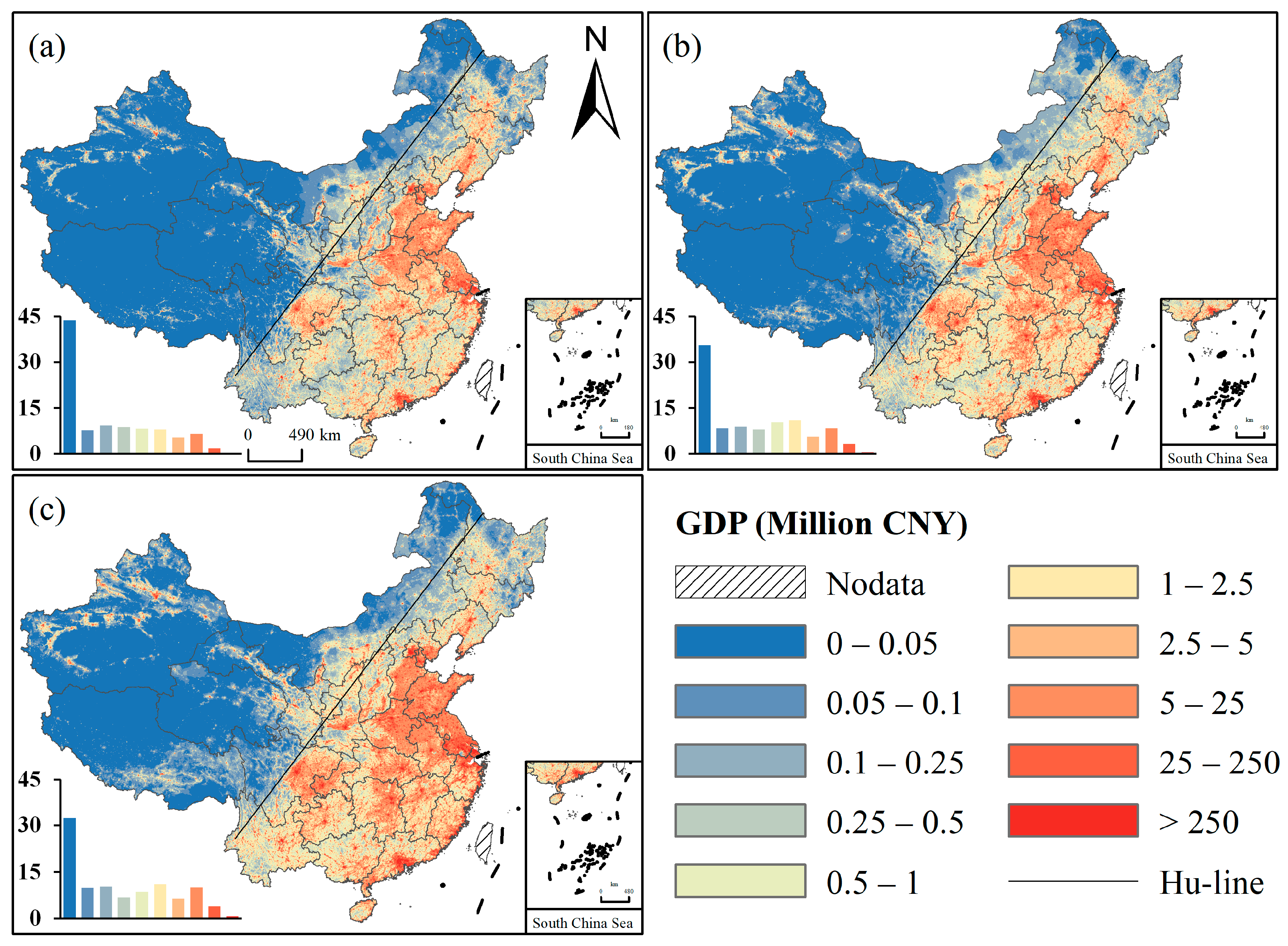
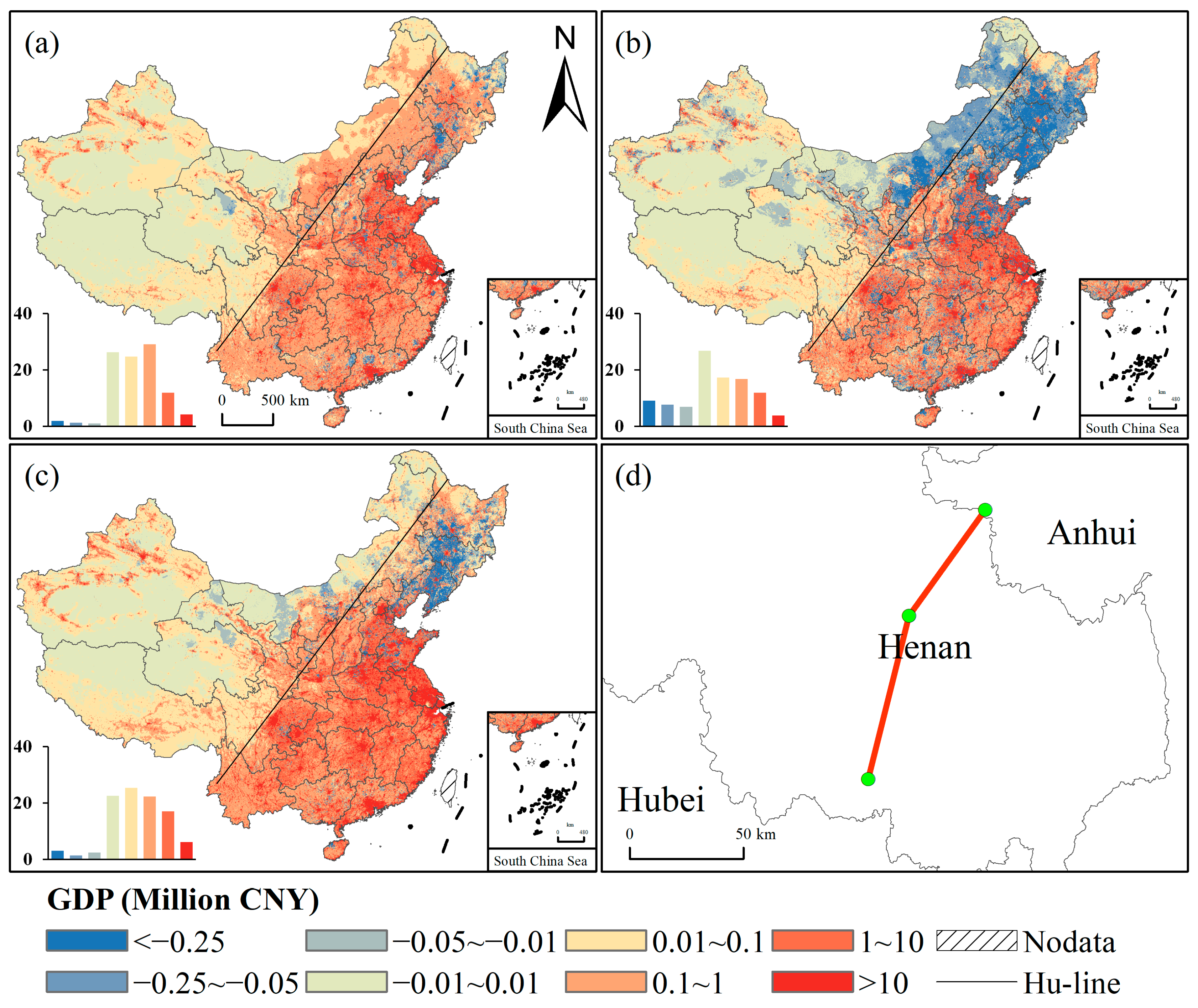
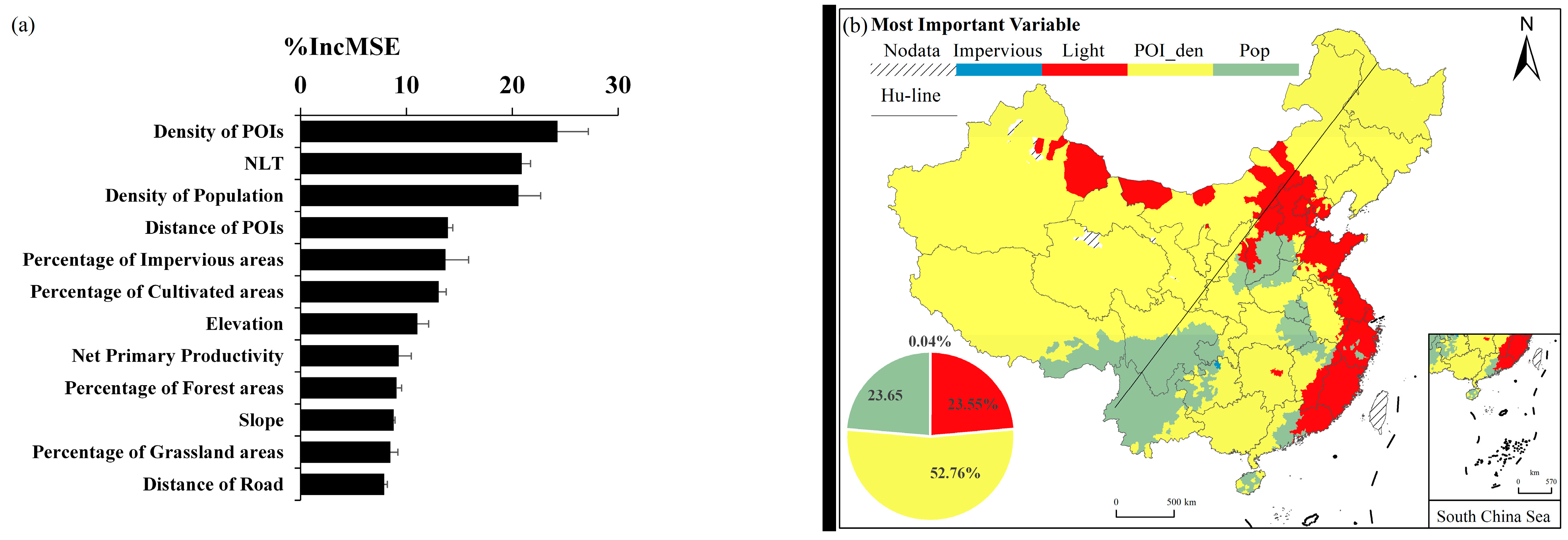

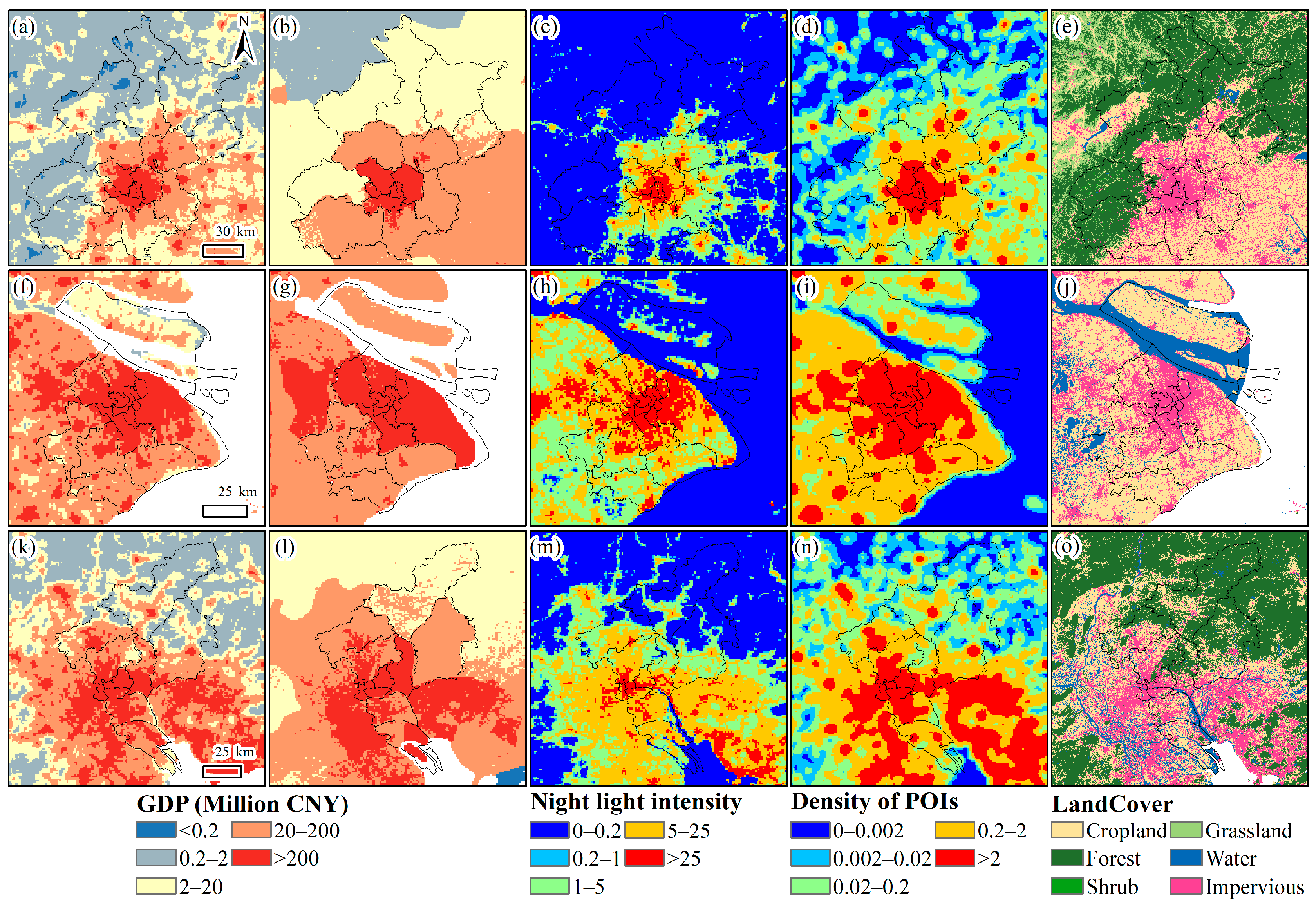
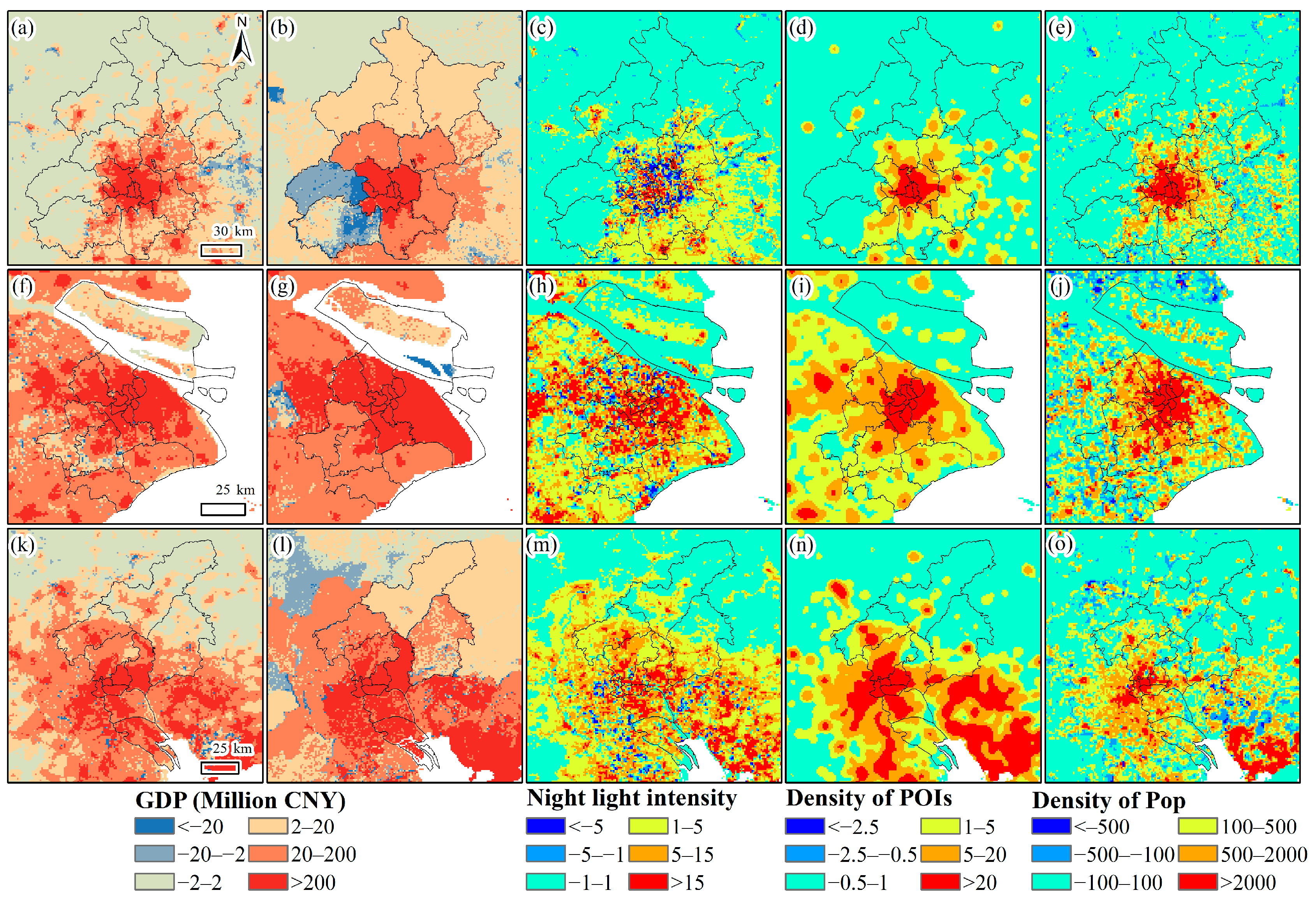
| Datasets | Temporal Coverage | Reference (Source) | Type/ Resolution |
|---|---|---|---|
| NTL data | 2010, 2015, and 2020 | Chen et al. [37] (https://dataverse.harvard.edu/dataset.xhtml?persistentId=doi:10.7910/DVN/YGIVCD (accessed on 10 May 2023)) | 1000 m |
| Land cover | 2010, 2015, and 2020 | Yang and Huang [38] (http://irsip.whu.edu.cn/resources/CLCD.php (accessed on 10 May 2023)) | 30 m |
| NPP | 2010, 2015, and 2020 | NASA (https://ladsweb.modaps.eosdis.nasa.gov (accessed on 10 May 2023)) | 1000 m |
| Population density | 2010, 2015, and 2020 | WorldPop Project [39] (https://hub.worldpop.org/doi/10.5258/SOTON/WP00645 (accessed on 10 May 2023)) | 100 m |
| POI and road | 2012, 2015, and 2020 | Gaode Map API (https://lbs.amap.com/ (accessed on 10 May 2023)) | shp |
| DEM | 2000 | National Aeronautics and Space Administration (NASA, http://srtm.csi.cgiar.org/srtmdata/ (accessed on 10 May 2023)) | 30 m |
| Name | 2010 | 2015 | 2020 | ||||||
|---|---|---|---|---|---|---|---|---|---|
| kbw (km) | %lm | Weight | kbw (km) | %lm | Weight | kbw (km) | %lm | Weight | |
| Food and beverages | 5 | 12.1 | 0.09 | 5 | 12.5 | 0.09 | 5 | 12.2 | 0.1 |
| Daily life service | 5 | 12 | 0.09 | 5 | 12.5 | 0.09 | 5 | 14 | 0.11 |
| Sport and recreation | 1 | 13.4 | 0.1 | 5 | 12 | 0.09 | 5 | 11.4 | 0.09 |
| Commercial houses | 5 | 12.5 | 0.09 | 4 | 13.2 | 0.09 | 5 | 14.8 | 0.12 |
| Governments | 5 | 10.5 | 0.08 | 5 | 12.1 | 0.09 | 4 | 15 | 0.12 |
| Education service | 2 | 14.9 | 0.11 | 1 | 16.4 | 0.12 | 4 | 14.5 | 0.11 |
| Transportation service | 4 | 11.7 | 0.08 | 4 | 12.4 | 0.09 | 5 | 11.7 | 0.09 |
| Finance service | 5 | 33.9 | 0.24 | 5 | 29.9 | 0.21 | 5 | 16.3 | 0.13 |
| Enterprises | 5 | 18.4 | 0.13 | 5 | 18.7 | 0.13 | 5 | 18.1 | 0.14 |
| (Million CNY) | 2010 | 2015 | 2020 |
|---|---|---|---|
| 0–0.05 | 43.82% | 35.50% | 32.44% |
| 0.05–0.1 | 7.65% | 8.39% | 9.81% |
| 0.1–1 | 26.42% | 27.26% | 25.54% |
| 1–25 | 19.90% | 25.05% | 27.54% |
| >25 | 2.21% | 3.80% | 4.68% |
| (Million CNY) | 2010–2015 | 2015–2020 | 2010–2020 |
|---|---|---|---|
| <−0.01 | 4.03% | 23.58% | 6.77% |
| −0.01~0.01 | 26.21% | 26.76% | 22.49% |
| 0.01~0.1 | 24.68% | 17.27% | 25.37% |
| >0.1 | 45.10% | 32.38% | 45.36% |
Disclaimer/Publisher’s Note: The statements, opinions and data contained in all publications are solely those of the individual author(s) and contributor(s) and not of MDPI and/or the editor(s). MDPI and/or the editor(s) disclaim responsibility for any injury to people or property resulting from any ideas, methods, instructions or products referred to in the content. |
© 2023 by the authors. Licensee MDPI, Basel, Switzerland. This article is an open access article distributed under the terms and conditions of the Creative Commons Attribution (CC BY) license (https://creativecommons.org/licenses/by/4.0/).
Share and Cite
Deng, F.; Cao, L.; Li, F.; Li, L.; Man, W.; Chen, Y.; Liu, W.; Peng, C. Mapping China’s Changing Gross Domestic Product Distribution Using Remotely Sensed and Point-of-Interest Data with Geographical Random Forest Model. Sustainability 2023, 15, 8062. https://doi.org/10.3390/su15108062
Deng F, Cao L, Li F, Li L, Man W, Chen Y, Liu W, Peng C. Mapping China’s Changing Gross Domestic Product Distribution Using Remotely Sensed and Point-of-Interest Data with Geographical Random Forest Model. Sustainability. 2023; 15(10):8062. https://doi.org/10.3390/su15108062
Chicago/Turabian StyleDeng, Fuliang, Luwei Cao, Fangzhou Li, Lanhui Li, Wang Man, Yijian Chen, Wenfeng Liu, and Chaofeng Peng. 2023. "Mapping China’s Changing Gross Domestic Product Distribution Using Remotely Sensed and Point-of-Interest Data with Geographical Random Forest Model" Sustainability 15, no. 10: 8062. https://doi.org/10.3390/su15108062
APA StyleDeng, F., Cao, L., Li, F., Li, L., Man, W., Chen, Y., Liu, W., & Peng, C. (2023). Mapping China’s Changing Gross Domestic Product Distribution Using Remotely Sensed and Point-of-Interest Data with Geographical Random Forest Model. Sustainability, 15(10), 8062. https://doi.org/10.3390/su15108062











